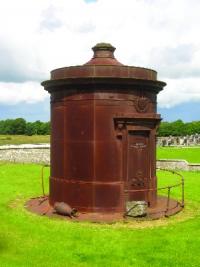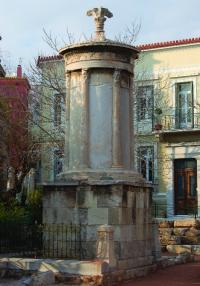The Dennis mausoleum, Co. Galway
Published in 18th–19th - Century History, Features, Issue 1 (Jan/Feb 2011), Volume 19
The Dennis mausoleum is modelled on the ancient choragic monument of Lysicrates (above), which still survives near the Acropolis in Athens. (NIAH)
One of the more remarkable structures in the country is the Dennis mausoleum, located in the old Clonbern graveyard, 21km north-east of Tuam, Co. Galway. It was erected in about 1865 to house the remains of Colonel Maurice Griffin Dennis (1805–63) and his wife Elizabeth, and they lie there still. After a successful military career in Africa and India, Colonel Dennis on his return to Ireland in 1857 married Elizabeth Eyre of Eyrecourt. In 1862 he acquired Birmingham House, Tuam, from his brother John.
Elizabeth Dennis was following Victorian custom in erecting a mausoleum for her husband with classical references, and its design reflects the taste of the period. The cast-iron cylindrical body of the structure is approximately 3.5m tall and 2m in diameter, constructed of panels that have ribs along the inside edges and are bolted together, four panels tall and twelve around. The base of the mausoleum rests on a bed of rubble and entrance was via a sliding door, which was jammed shut in the 1960s to prevent vandalism. A draped urn, now detached, formerly crowned the apex of the roof. Draped urns are a common feature of Victorian mausoleums, as a symbolic representation of the ancient practice of using an urn to hold the ashes of the cremated dead. The cloth guards the ashes or signifies the separation between life and death.
The door architrave and the coat of arms above the door are riveted onto the cylinder, as are the framed panels of text. The door carries the inscription ‘Mausoleum/Sacred to
 the memory of/Col. Maurice Griffin Dennis/1st battalion/60th Kings Royal Rifles/Who fell asleep in Jesus/This mausoleum is …/Elizabeth Dennis otherwise Eyre’. Around the cylinder are the remains of other biblical framed text, most of which has become detached. Most fragments are missing: the recovered parts are now in safekeeping. Each of the panels also appears to have had a wreath. The remains of a railing circle the mausoleum, together with twelve decorated posts.
the memory of/Col. Maurice Griffin Dennis/1st battalion/60th Kings Royal Rifles/Who fell asleep in Jesus/This mausoleum is …/Elizabeth Dennis otherwise Eyre’. Around the cylinder are the remains of other biblical framed text, most of which has become detached. Most fragments are missing: the recovered parts are now in safekeeping. Each of the panels also appears to have had a wreath. The remains of a railing circle the mausoleum, together with twelve decorated posts.
The Dennis mausoleum is modelled on the ancient choragic monument of Lysicrates, which still survives near the Acropolis in Athens. It was erected by the choregos Lysicrates, a patron of many theatrical performances in the nearby Theatre of Dionysus, to commemorate a victory c. 335 BC. (Choregos was an honorary title for Athenian citizens who financed the chorus in dramatic productions.) Demonstrating the correct use of the Corinthian order, the monument was much drawn and later photographed by travellers, and the theme of a circular base surmounted by an emblem was widely copied.
Research in old pattern books has uncovered no clues as to the manufacturer of the Dennis mausoleum and there are no apparent identifying marks on the structure itself. Was it imported in kit form to be assembled in the graveyard? Maurice Craig in his book Mausolea Hibernica (where a drawing by Michael Craig reconstructs the monument in its original form) suggests that it was probably cast in Scotland by the Carron Ironworks or some such firm.
The mausoleum was damaged a number of years ago by a storm and subsequent vandalism. Galway County Council Conservation Office is undertaking a conservation project with grant aid from the Civic Structure Conservation Grant Scheme and a Heritage Council Maintenance Grant. The project is supported by
the Clonbern Community Development Council and the Follies Trust. HI
Máirín Doddy is Conservation Officer, Galway County Council. Series based on the National Inventory of Architectural Heritage’s ‘building of the month’, www.buildingsofireland.com.
















